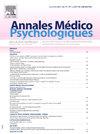心理治疗技术如何变得“科学”?三种“伪科学”心理创伤治疗方法的比较分析
IF 0.5
4区 医学
Q4 PSYCHIATRY
引用次数: 0
摘要
近几十年来,出现了许多治疗创伤后应激障碍患者的心理疗法。本文重点介绍了眼动脱敏与再加工(EMDR)、思维场疗法(TFT)和情绪释放技术(EFT)。作为能量疗法运动的一部分,它们被推动者视为革命性的方法,并在科学界引起了相当大的争议。然而,EMDR现在是创伤后应激障碍的标准治疗方法。另一方面,TFT和EFT仍然被描述为“伪科学”。为了更好地理解解释这种差异的因素,我们分析了EMDR、TFT和EFT的发展方式。因此,我们研究了鼓励这些方法出现的因素,但也研究了它们在各自的科学验证道路上遇到的反对意见。为了进行比较分析,我们对文献进行了非系统回顾。为此,我们查阅了参考文献,并使用几个科学数据库收集了与EMDR、EFT和TFT相关的文章。我们的分析总共涵盖了37篇文章,包括11篇文献综述、8本书和7篇卫生保健机构制作的其他文件(报告、证据综述、治疗指南)。结果在简要介绍EMDR、TFT和EFT后,我们首先研究了促使它们出现的因素。我们确定了其中的三个因素:20世纪下半叶心理疗法的兴起,“概念蔓延”的概念,以及替代和补充医学的普及。正是这些因素的结合为动力疗法的出现创造了有利的环境。与此同时,EMDR、TFT和EFT也因其不一致的理论基础、其初始研究的方法质量差以及可疑的推广策略而受到批评。由于所有这些原因,科学界一再给它们贴上“伪科学”的标签。这些结果使我们开始讨论“伪科学”的概念。在我们的研究结束时,我们发现,迄今为止制定的各种标准并没有使我们能够在“科学”和“伪科学”之间划清界限。考虑到这一点,我们对如何评估心理疗法进行了批判性的研究,并试图确定EMDR、TFT和EFT各自的科学地位。尽管其理论基础不一致,但EMDR是最接近科学有效的方法。另一方面,EFT缺乏足够的证据证明其有效性,但已作出努力使其做法标准化,以期促进其评价。最后,TFT是最接近伪科学的方法。这篇文章显示了某些心理治疗流派产生的科学、社会学和社会背景的重要性,以及这种背景对其发展的影响。本文的结论不仅要求对EMDR、TFT和EFT进行进一步的研究,而且还要求对法国用于评估心理治疗的方法和补充治疗在某些精神障碍治疗中的地位进行反思。本文章由计算机程序翻译,如有差异,请以英文原文为准。
Comment une technique de psychothérapie devient-elle « scientifique » ? Analyse comparée de trois méthodes de traitement du psychotraumatisme jugées « pseudo-scientifiques »
Context
In recent decades, numerous psychotherapy methods have emerged to treat individuals suffering from post-traumatic stress disorder. This article focuses on three of them: Eye Movement Desensitization and Reprocessing (EMDR), Thought Field Therapy (TFT) and Emotional Freedom Technique (EFT). Belonging to the Power Therapies movement, they have been presented as revolutionary methods by their promoters and have been the subject of considerable controversy within the scientific community. However, EMDR is now a standard treatment for post-traumatic stress disorder. TFT and EFT, on the other hand, are still described as “pseudosciences”. In order to gain a better understanding of the factors that explain this difference, we analysed the way in which EMDR, TFT and EFT developed. We therefore looked at the factors which encouraged the emergence of these methods, but also at the opposition they encountered in their respective paths to scientific validation.
Methodology
In order to conduct our comparative analysis, we carried out a non-systematic review of the literature. To do this, we consulted reference works and collected articles relating to EMDR, EFT and TFT using several scientific databases. In total, our analysis covered thirty-seven articles, including eleven reviews of literature, eight books and seven other documents (reports, reviews of evidence, treatment guidelines) produced by health care institutions.
Results
After a brief presentation of EMDR, TFT and EFT, we first looked at the factors which encouraged their emergence. We identified three of these: the rise of psychotherapies in the second half of the twentieth century, the notion of “concept creep”, and the popularisation of alternative and complementary medicine. It is this combination of factors that has created a favourable context for the emergence of Power Therapies. At the same time, EMDR, TFT and EFT have also been criticised for their inconsistent theoretical foundations, the poor methodological quality of their initial studies, and questionable promotional tactics. For all these reasons, the scientific community has repeatedly labelled them “pseudosciences”.
Discussion
These results led us to discuss the notion of “pseudoscience”. At the end of our research, it appeared to us that the various criteria developed to date did not make it possible to draw a clear line between “science” and “pseudoscience”. With this in mind, we took a critical look at how psychotherapies are evaluated, and tried to determine the respective scientific status of EMDR, TFT and EFT. Despite its inconsistent theoretical foundations, EMDR is the method that comes closest to being scientifically valid. EFT, on the other hand, lacks sufficient evidence to prove its effectiveness, but efforts to standardise its practice have been made with a view to facilitating its evaluation. Finally, TFT is the method that comes closest to being a pseudoscience.
Conclusion
This article shows the importance of the scientific, sociological and societal context in which certain currents of psychotherapy emerge, and the impact this context can have on their development. The conclusions of this article not only call for further research into EMDR, TFT and EFT, but also for reflection on the methods used to evaluate psychotherapies and the place of complementary therapies in the treatment of certain mental disorders in France.
求助全文
通过发布文献求助,成功后即可免费获取论文全文。
去求助
来源期刊

Annales medico-psychologiques
医学-精神病学
CiteScore
1.30
自引率
33.30%
发文量
196
审稿时长
4-8 weeks
期刊介绍:
The Annales Médico-Psychologiques is a peer-reviewed medical journal covering the field of psychiatry. Articles are published in French or in English. The journal was established in 1843 and is published by Elsevier on behalf of the Société Médico-Psychologique.
The journal publishes 10 times a year original articles covering biological, genetic, psychological, forensic and cultural issues relevant to the diagnosis and treatment of mental illness, as well as peer reviewed articles that have been presented and discussed during meetings of the Société Médico-Psychologique.To report on the major currents of thought of contemporary psychiatry, and to publish clinical and biological research of international standard, these are the aims of the Annales Médico-Psychologiques.
 求助内容:
求助内容: 应助结果提醒方式:
应助结果提醒方式:


